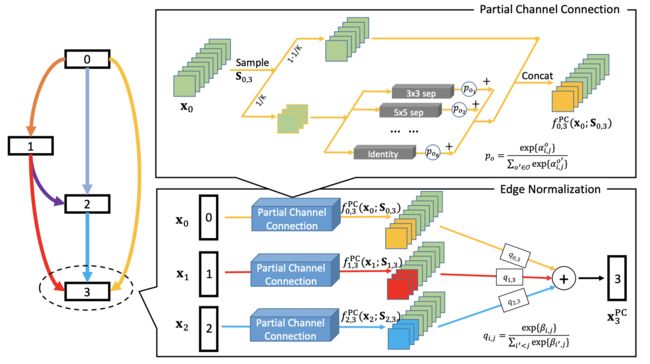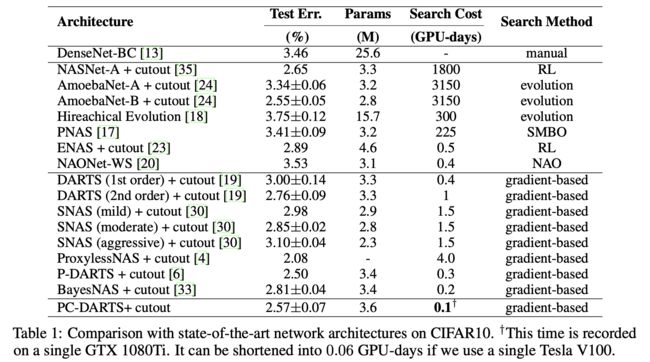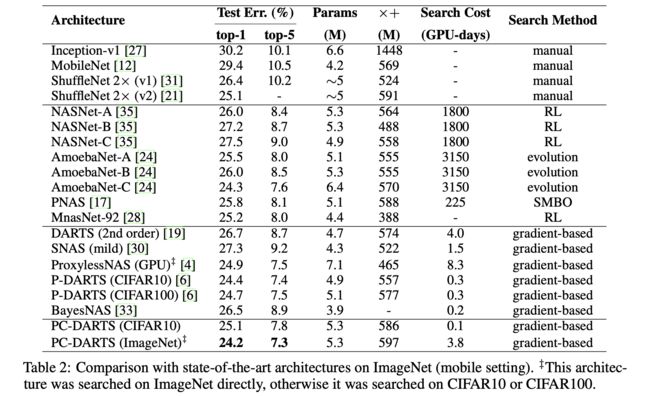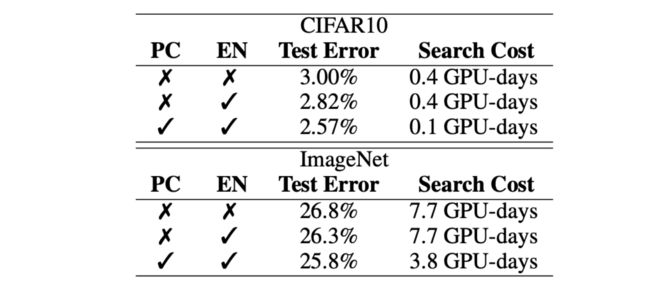神经网络架构搜索——可微分搜索(PC-DARTS)
神经网络架构搜索——可微分搜索(PC-DARTS)
-
-
- 动机
- 贡献点
- 方法
-
- 部分通道连接(Partial Channel Connection)
- 边缘正规化(Edge Normalization)
- 实验结果
-
- CIFAR-10
- ImageNet
- 消融实验
- 参考
-
华为发表在ICLR 2020上的NAS工作,针对现有DARTS模型训练时需要 Large memory and computing 问题,提出了 Partial Channel Connection 和 Edge Normalization 的技术,在搜索过程中更快更好。
- aper: PC-DARTS: Partial Channel Connections for Memory-Efficient Differentiable Architecture Search
- Code: https://github.com/yuhuixu1993/PC-DARTS
动机
接着上面的P-DARTS来看,尽管上面可以在17 cells情况下单卡完成搜索,但妥协牺牲的是operation的数量,这明显不是个优秀的方案,故此文 Partially-Connected DARTS,致力于大规模节省计算量和memory,从而进行快速且大batchsize的搜索。
贡献点
-
设计了基于channel的sampling机制,故每次只有小部分1/K channel的node来进行operation search,减少了(K-1)/K 的memory,故batchsize可增大为K倍。
-
为了解决上述channel采样导致的不稳定性,提出了 边缘正规化(edge normalization),在搜索时通过学习edge-level超参来减少不确定性。
方法
部分通道连接(Partial Channel Connection)
如上图的上半部分,在所有的通道数K里随机采样 1/K 出来,进行 operation search,然后operation 混合后的结果与剩下的 (K-1)/K 通道数进行 concat,公式表示如下:
f i , j P C ( x i ; S i , j ) = ∑ o ∈ O exp { α i , j o } ∑ o ′ ∈ O exp { α i , j o ′ } ⋅ o ( S i , j ∗ x i ) + ( 1 − S i , j ) ∗ x i f_{i, j}^{\mathrm{PC}}\left(\mathbf{x}_{i} ; \mathbf{S}_{i, j}\right)=\sum_{o \in \mathcal{O}} \frac{\exp \left\{\alpha_{i, j}^{o}\right\}}{\sum_{o^{\prime} \in \mathcal{O}} \exp \left\{\alpha_{i, j}^{o^{\prime}}\right\}} \cdot o\left(\mathbf{S}_{i, j} * \mathbf{x}_{i}\right)+\left(1-\mathbf{S}_{i, j}\right) * \mathbf{x}_{i} fi,jPC(xi;Si,j)=o∈O∑∑o′∈Oexp{αi,jo′}exp{αi,jo}⋅o(Si,j∗xi)+(1−Si,j)∗xi
上述的“部分通道连接”操作会带来一些正副作用:
- 正作用:能减少operations选择时的biases,弱化无参的子操作(Pooling, Skip-Connect)的作用。文中3.3节有这么一句话:当proxy dataset非常难时(即ImageNet),往往一开始都会累积很大权重在weight-free operation,故制约了其在ImageNet上直接搜索的性能。
- 副作用:由于网络架构在不同iterations优化是基于随机采样的channels,故最优的edge连通性将会不稳定。
class MixedOp(nn.Module):
def __init__(self, C, stride):
super(MixedOp, self).__init__()
self._ops = nn.ModuleList()
self.mp = nn.MaxPool2d(2,2)
for primitive in PRIMITIVES:
op = OPS[primitive](C //4, stride, False)
if 'pool' in primitive:
op = nn.Sequential(op, nn.BatchNorm2d(C //4, affine=False))
self._ops.append(op)
def forward(self, x, weights):
#channel proportion k=4(实验证明1/4性能最佳)
dim_2 = x.shape[1]
xtemp = x[ : , : dim_2//4, :, :] # channel 0到1/4的输入
xtemp2 = x[ : , dim_2//4:, :, :] # channel 1/4到1的输入
temp1 = sum(w * op(xtemp) for w, op in zip(weights, self._ops)) # 仅1/4数据参与ops运算
#reduction cell 需要在concat之前添加pooling操作
if temp1.shape[2] == x.shape[2]:
ans = torch.cat([temp1,xtemp2],dim=1)
else:
ans = torch.cat([temp1,self.mp(xtemp2)], dim=1)
ans = channel_shuffle(ans,4) # 一个cell完成后对channel进行随机打散,为下个cell做采样准备
#ans = torch.cat([ans[ : , dim_2//4:, :, :],ans[ : , : dim_2//4, :, :]],dim=1)
#except channe shuffle, channel shift also works
return ans
def channel_shuffle(x, groups):
batchsize, num_channels, height, width = x.data.size()
channels_per_group = num_channels // groups
# reshape [batchsize, num_channels, height, width]
# -> [batchsize, groups,channels_per_group, height, width]
x = x.view(batchsize, groups,
channels_per_group, height, width)
# 打乱channel的操作(借助transpose后数据块的stride发生变化,然后将其连续化)
# 参考:https://www.cnblogs.com/aoru45/p/10974508.html
x = torch.transpose(x, 1, 2).contiguous()
# flatten
x = x.view(batchsize, -1, height, width)
return x
边缘正规化(Edge Normalization)
为了克服部分通道连接这个副作用,提出边缘正规化(见上图的下半部分),即把多个PC后的node输入softmax权值叠加,类attention机制
x j P C = ∑ o ∈ O exp { α i , j o } ∑ o ′ ∈ O exp { α i , j o ′ } ⋅ o ( S i , j ∗ x i ) + ( 1 − S i , j ) ∗ x i \mathbf{x}_{j}^{\mathrm{PC}}=\sum_{o \in \mathcal{O}} \frac{\exp \left\{\alpha_{i, j}^{o}\right\}}{\sum_{o^{\prime} \in \mathcal{O}} \exp \left\{\alpha_{i, j}^{o^{\prime}}\right\}} \cdot o\left(\mathbf{S}_{i, j} * \mathbf{x}_{i}\right)+\left(1-\mathbf{S}_{i, j}\right) * \mathbf{x}_{i} xjPC=o∈O∑∑o′∈Oexp{αi,jo′}exp{αi,jo}⋅o(Si,j∗xi)+(1−Si,j)∗xi
x j P C = ∑ i < j exp { β i , j } ∑ i ′ < j exp { β i ′ , j } ⋅ f i , j ( x i ) \mathbf{x}_{j}^{\mathrm{PC}}=\sum_{i < j} \frac{\exp \left\{\beta_{i, j}\right\}}{\sum_{i^{\prime} < j} \exp \left\{\beta_{i^{\prime}, j}\right\}} \cdot f_{i, j}\left(\mathbf{x}_{i}\right) xjPC=i<j∑∑i′<jexp{βi′,j}exp{βi,j}⋅fi,j(xi)
由于edge 超参 β i , j \beta_{i, j} βi,j 在训练阶段是共享的,故学习到的网络更少依赖于不同iterations间的采样到的channels,使得网络搜索过程更稳定。当网络搜索完毕,node间的operation选择由operation-level和edge-level的参数相乘后共同决定。
weights_normal = [F.softmax(alpha, dim=-1) for alpha in alpha_normal]
weights_reduce = [F.softmax(alpha, dim=-1) for alpha in alpha_reduce]
weights_edge_normal = [F.softmax(beta, dim=0) for beta in beta_normal]
weights_edge_reduce = [F.softmax(beta, dim=0) for beta in beta_reduce]
def parse(alpha, beta, k):
...
for edges, w in zip(alpha, beta):
edge_max, primitive_indices = torch.topk((w.view(-1, 1) * edges)[:, :-1], 1) # ignore 'none'
...
实验结果
CIFAR-10
ImageNet
消融实验
参考
[1] Yuhui Xu et al. ,PC-DARTS: Partial Channel Connections for Memory-Efficient Differentiable Architecture Search
[2] https://zhuanlan.zhihu.com/p/73740783
![]()



